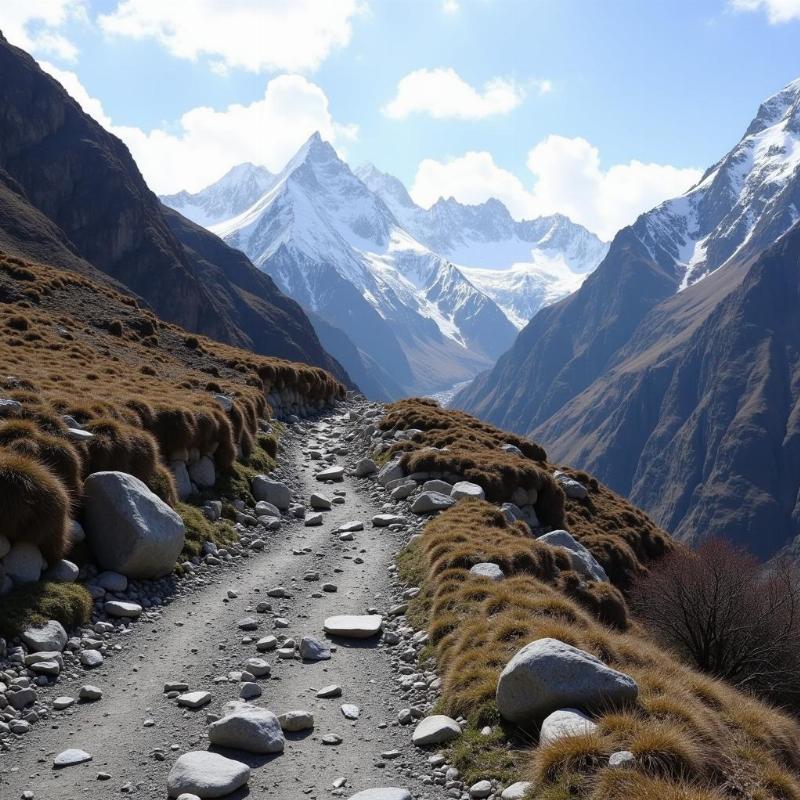India, a land of vibrant cultures and breathtaking landscapes, also harbors some places that require a cautious approach. From challenging terrains to areas with a history of unrest, understanding the potential risks associated with certain destinations is crucial for a safe and enjoyable trip. This article explores some of the dangerous places in India, empowering travelers with the knowledge they need to make informed decisions.
Navigating the Risks: A Closer Look at Dangerous Places in India
India’s diverse geography presents a range of challenges, from the towering Himalayas to the dense jungles of the northeast. Some areas pose significant risks due to natural disasters, wildlife encounters, or socio-political instability. Let’s delve into specific locations and the dangers they present.
The Treacherous Terrain of the Himalayas
The Himalayas, while majestic, are prone to landslides, avalanches, and altitude sickness. Trekking in these regions demands careful planning, proper acclimatization, and experienced guides. Certain areas, particularly during the monsoon season, become extremely dangerous due to unpredictable weather patterns.
 Himalayan Trek Landslide
Himalayan Trek Landslide
The Wilds of Northeast India: Navigating Nature’s Challenges
The northeastern states of India, known for their biodiversity, also harbor dense forests and wildlife sanctuaries. Venturing into these areas requires vigilance, as encounters with wild animals, including tigers and elephants, are a possibility. Respecting wildlife boundaries and adhering to local guidelines is paramount.
Areas of Socio-Political Sensitivity
Certain regions in India experience periods of socio-political unrest, posing potential safety risks for travelers. Staying updated on current affairs and heeding travel advisories issued by the government is crucial before visiting such areas. It’s advisable to exercise caution and avoid unnecessary risks.
Daring the Depths: Exploring Underwater Dangers
India’s coastline, while beautiful, can be dangerous in certain areas due to strong currents, riptides, and the presence of marine life like jellyfish and sharks. Swimming in designated areas and following safety guidelines is essential. Always be aware of the local warnings and flags on the beaches.
Staying Safe: Tips for Navigating Dangerous Places in India
While some places may present higher risks, proper preparation and awareness can significantly mitigate those dangers. Here are some key tips for staying safe:
- Thorough Research: Before embarking on your journey, research your destination thoroughly. Understand the potential risks and take necessary precautions.
- Local Guidance: Engage with local guides and experts who possess valuable knowledge about the area. They can provide insights into safe practices and help you navigate challenging terrains.
- Emergency Preparedness: Always have an emergency plan in place. Pack a first-aid kit, inform someone about your whereabouts, and have emergency contact numbers readily available.
- Respect Local Customs: Be mindful of local customs and traditions. Respecting local sensitivities can contribute to a safer and more enriching travel experience.
Conclusion: Embrace the Adventure, Prioritize Safety
Exploring India’s diverse landscapes is an enriching experience. While certain locations may pose dangers, careful planning, awareness, and respect for local conditions can help ensure a safe and memorable journey. By acknowledging the potential risks and taking necessary precautions, you can embrace the adventure while prioritizing your safety.
FAQ:
- What are some of the most dangerous trekking routes in the Himalayas? Some challenging routes include the Chadar Trek, Stok Kangri Trek, and Auden’s Col.
- Are there any specific precautions for visiting wildlife sanctuaries in Northeast India? Yes, it’s crucial to follow park regulations, maintain a safe distance from animals, and avoid venturing out alone.
- Where can I find updated travel advisories for India? The Ministry of Home Affairs and the Ministry of External Affairs provide official travel advisories.
- Are there any dangerous beaches in India? Some beaches with strong currents include Kanyakumari Beach, Gokarna Beach, and Chowpatty Beach.
- What should I do in case of a medical emergency while traveling in India? Contact local emergency services and inform your embassy or consulate.
- Is it safe to travel alone in India? Traveling alone is possible, but extra precautions are recommended, particularly for women.
- What are some common scams to be aware of in India? Be cautious of inflated prices, fake tour guides, and rigged taxis.
Related Articles:
- Trekking places in Trivandrum
- Waterfall trip
- Best places in Maharashtra in monsoon
- Places to visit in Konkan in monsoon
PlaTovi, a leading travel company in India, offers a wide range of travel services, including curated tours, hotel bookings, and transportation assistance. We specialize in creating unforgettable travel experiences while ensuring the safety and comfort of our clients. Our expertise in both domestic and international travel allows us to cater to the diverse needs of today’s travelers. Whether you are seeking a relaxing beach vacation or a thrilling adventure in the Himalayas, PlaTovi can help you plan your perfect trip. Contact us at [email protected] or call us at +91 22-2517-3581 to start planning your next adventure.